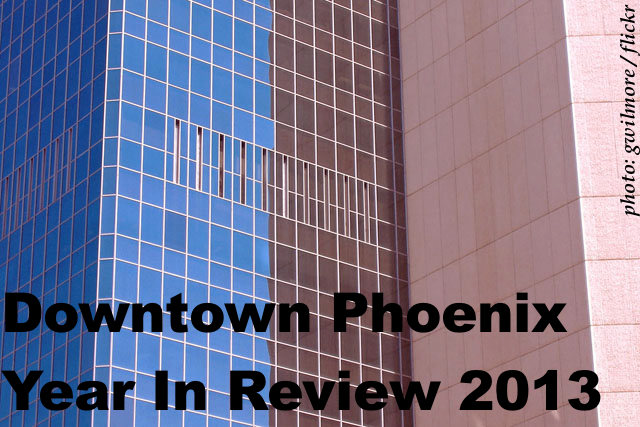In these past couple weeks, I’ve been thinking about the things that have happened in 2013 in downtown Phoenix and how they shape its present as well as the next year in our community. Re-read my observations on downtown’s strengths, weaknesses, and threats first before reading this finale post.
 A DOWNTOWN PHOENIX YEAR-IN-REVIEW 2013: IV. OPPORTUNITIES
A DOWNTOWN PHOENIX YEAR-IN-REVIEW 2013: IV. OPPORTUNITIES
1. Arizona Center for Law and Society — As part of the growth of ASU’s Downtown Phoenix campus, ASU administration is planning to move their Sandra Day O’Connor College of Law to downtown Phoenix in a new building, the Arizona Center for Law and Society. The building will be a great asset to the growing University District in downtown Phoenix. While many people bemoan the design of the building including its placement of an alumni-run law firm on the 1st Street sidewalk-level elevation, my chief concern is about how public the building will remain given ASU central administration’s desire to clamp down on access to their buildings, especially downtown. Let’s get this building built before somebody changes their mind.
2. 1st Street Redesign — It is nice that the City is starting to think creatively about what to do with downtown streets. The redesign of 1st Street from Washington to Hance Park is certainly eye-opening and also includes Phoenix’s first parklet (miniature park) near Garfield Street, outside Matt’s Big Breakfast. The narrowing of one of downtown’s widest streets has made it possible for more non-automobile users to take advantage of that street but the stock of buildings and their non-engagement to the 1st Street streetscape makes it curious why that street was chosen as a demonstration project. Still, though, progress is progress and it’s good that the City is looking at streets in a different light.
3. Rising Interest in Bicycling in Urban Phoenix — As 2013 closes, we are inching closer to becoming a good place to bicycle. The City’s Street Transportation recently seated a twelve-member Bicycling & Pedestrian Ad Hoc Task Force (of which I am a member), of which one of its charges is to at the City’s new bicycling master plan in parallel with two national engineering firms specializing in bicycling infrastructure. In addition, bicycle share is coming to central Phoenix in 2014. While I believe that downtown’s adequate bicycle infrastructure should have been installed before bicycle share, I hope that this new citywide look at bicycling will usher in the much-needed improvements to downtown’s bicycling infrastructure.
4. New City Council Representatives for Districts 4 and 8 — Two of Phoenix’s council districts containing urban Phoenix will have new representation in January: Laura Pastor in District 4 (Midtown, Maryvale) and Kate Gallego in District 8 (Downtown East, Sky Harbor, South Phoenix). I had the great opportunity to interview both of these women and so I am hopeful for what they will seek to accomplish in their first term. Both Districts 4 and 8 contain neighborhoods that are truly coming into their own identities and I would hope that the new councilwomen can find the best way to work with the neighborhoods and celebrate the progress that has happened.
 5. Setting the Stage for the 2015 Super Bowl — In February 2015, the world will descend to metropolitan Phoenix for the 49th annual playing of the NFL’s championship game. It’s a foregone conclusion that the game will be in Glendale at the University of Phoenix Stadium. But it is supposed to be announced that the NFL’s major events will take place in downtown Phoenix and all that is happening here will be on the national and international stage. This is a major opportunity for everyone here to put their best foot forward and I think everyone understands the stakes that are at hand. I would hope that we look to tell downtown Phoenix’s story as this: urban living is celebrated here.
5. Setting the Stage for the 2015 Super Bowl — In February 2015, the world will descend to metropolitan Phoenix for the 49th annual playing of the NFL’s championship game. It’s a foregone conclusion that the game will be in Glendale at the University of Phoenix Stadium. But it is supposed to be announced that the NFL’s major events will take place in downtown Phoenix and all that is happening here will be on the national and international stage. This is a major opportunity for everyone here to put their best foot forward and I think everyone understands the stakes that are at hand. I would hope that we look to tell downtown Phoenix’s story as this: urban living is celebrated here.
 2.
2. 